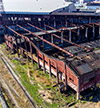Around the Horn: Getting Power to Projects-A Discussion
Guest Editor Bradley Migdal leads an illuminating discussion with Karla T. Moran, Manager of Economic Development at Salt River Project, and Coleman Peiffer, Senior Business Attraction Manager at Alliant Energy, exploring infrastructure challenges and solutions for large-scale manufacturing and data center projects. This conversation has been lightly edited for style and space.
Q2 2024
Karla T. Moran: We're quoting about four years for constructing a substation, mainly due to the long lead times required for transformers and circuit breakers. Especially in our service territory, where data centers commonly exceed 300 megawatts, the demand is massive and comparable to the output of some power plants. They require an obscene amount of power which are similar in size to some of our power plants. The infrastructure requirements and upgrades are extensive to meet these power loads.
Bradley: How do you handle upgrades and discussions with new clients?
Karla T. Moran: It’s really about two conversations: one about the necessary infrastructure upgrades and another on resource allocation. If a client is new and not included in our existing plans, we must integrate their needs, which complicates timing.
Coleman Peiffer: For significant projects, especially those requiring upgrades like a 345-megawatt transformer, the lead time is about 48-60 months. Smaller transformers are 24-36 months. We can sometimes expedite to about two to three years if the end user commits financially.
Bradley: When should site selection discussions start?
Coleman Peiffer: The sooner the better, right? The best time to start talking is immediately after identifying potential land. Understanding the site's power capacity and the timeline for power delivery is crucial. Early discussions help us align on the total power usage and ramp-up period. What we need to know is, what will your total use look like, and then what does that ramp up period look like? That helps us identify if and how we can hit your electrification date.
Karla T. Moran: In Phoenix, even smaller projects need early involvement due to our rapid infrastructure expansion.
We're meeting with all our city partners on a regular basis to see if there's anything that's going through rezone that we need to be aware of, or if there's anybody kicking tires on a bigger site, so we make sure we're part of the conversation. I basically tell anybody, if you're looking at a site, there will need to be some work and upgrades done because the full power capacity is likely not available.
Bradley: What considerations should site selectors have regarding power capacity?
Karla T. Moran: It’s essential to know if a site can handle the expected load. For projects that align with economic development, we've pre-ordered equipment to expedite processes. Manufacturers need precise cost and timeline estimates due to their budget sensitivities.
Coleman Peiffer: In Wisconsin, we proactively perform power studies to ensure sites are ready within three years, facilitating better site marketing. Historically, we've required an end user to request that. We're going and doing those on our own, so that we can then market the site as something that's going to be power ready within three years.
Bradley: Looking ahead, what are the prospects for meeting growing power demands?
Coleman Peiffer: We’re focusing on integrating renewable energy sources like solar and wind with battery storage to meet future needs. This approach helps manage the increasing demands from data centers and advanced manufacturing.
Karla T. Moran: We’re also pushing for more solar power and exploring long-duration battery storage solutions to handle night-time energy needs, especially for electric vehicles which predominantly charge at night.
Bradley: If you look back into history, have you ever seen these types of demands ever?
Karla: The demand requirements on the data centers is unreal. We do have an AI data center under testing in our market, and it's very interesting, because it ramps up to double digit megawatts and then just drops. AI technology is changing and challenging market now.
Coleman: A three-to-five-megawatt project, when I started at Alliant six years ago, was a good project. Now every lead I get from an RFP is like 10, 15 megawatts or more.
Bradley: Is there any advice that you can give to the readers of Area Development Magazine, about talking to your power providers and when? What are your parting thoughts?
Coleman: I would say, especially for new industrial park growth or new area growth, as soon as you identify land that you think your community might want to take control over or turn it into a park, you should be talking to your electric utility first, to make sure that there's power capacity, and infrastructure to get power there. If you don't have it at that site, the site is not going to be nearly as attractive. If you do have it, and you control the land, you've now created somewhat of a unicorn site.
Karla: The data center industry is aware they must be part of the solution. There have been a lot more of these clients willing to work together and be partners. They put billions of dollars and infrastructure in the ground here. They want to make sure that they have power to serve it.
Project Announcements
First Solar Plans Gaffney, South Carolina, Operations
11/15/2025
Norway-Based Vianode Plans St. Thomas, Ontario, Canada, Operations
11/14/2025
Ireland-Based CEL Critical Power Plans James City County, Virginia, Manufacturing Operations
11/13/2025
Aclara Resources Plans Calcasieu Parish, Louisiana, Heavy Rare Earth Separation Operations
11/04/2025
Eos Energy Enterprises Expands Allegheny County, Pennsylvania, Operations
11/01/2025
Germany-Based Becker Mining Systems Plans Mount Vernon, Ohio, Manufacturing Operations
10/18/2025
Most Read
-
The Workforce Bottleneck in America’s Manufacturing Revival
Q4 2025
-
Rethinking Local Governments Through Consolidation and Choice
Q3 2025
-
Lead with Facts, Land the Deal
Q3 2025
-
Investors Seek Shelter in Food-Focused Real Estate
Q3 2025
-
Tariff Shockwaves Hit the Industrial Sector
Q4 2025
-
America’s Aerospace Reboot
Q3 2025
-
The Permit Puzzle and the Path to Groundbreaking
Q3 2025



